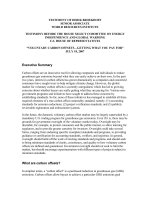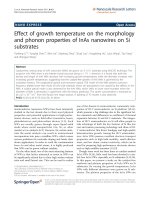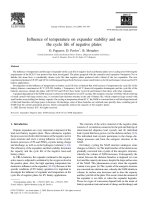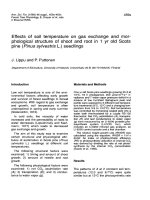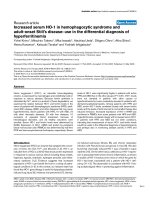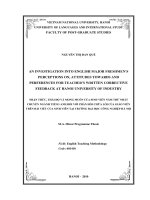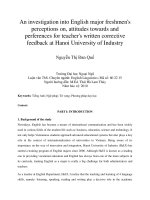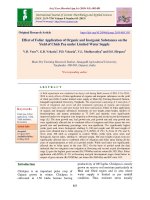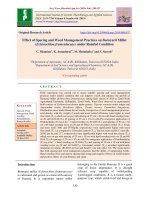Effect of storage under low temperature on pupal duration and adult emergence of S. inferens
Bạn đang xem bản rút gọn của tài liệu. Xem và tải ngay bản đầy đủ của tài liệu tại đây (188.09 KB, 5 trang )
Int.J.Curr.Microbiol.App.Sci (2018) 7(8): 4464-4468
International Journal of Current Microbiology and Applied Sciences
ISSN: 2319-7706 Volume 7 Number 08 (2018)
Journal homepage:
Original Research Article
/>
Effect of Storage under Low Temperature on Pupal Duration and
Adult Emergence of S. inferens
Sonali Deole1*, V.K. Dubey1, Dipti Dash2 and Rashmi Gauraha1
1
Department of Entomology, 2Department of Agriculture Microbiology,
Indira Gandhi Krishi Vishwavidyalaya, Raipur, Chhattisgarh, India-492012
*Corresponding author
ABSTRACT
Keywords
Duration,
Emergence, Low
temperature, S.
inferens
Article Info
Accepted:
26 July 2018
Available Online:
10 August 2018
The present investigation was conducted during spring seasons of year
2014-15 at the poly house at college of Agriculture, Indira Gandhi Krishi
Vishwavidyalaya, Raipur. Pupal period prolonged significantly when the
pupae of different ages were kept at 100 C as compared to ambient
temperature. Among all the treatments, pupal duration was significantly
prolonged with 7 days (24.20 days) followed by 5 days (23.30 days) old
pupae. Maximum emergences of 84.33 per cent was recorded when pupae
were exposed to 100 C for five days and the emergence was however
reduced to 52.67 per cent when pupae were exposed to 15 days.
Introduction
Maize (Zea mays) is one of the world’s most
important cereal crops. Its wide genetic
diversity and multiple uses account for its
cultivation in a large range of environments
(IITA, 1991). More than 700 million people
in the developing world do not have access to
sufficient food to meet their need for healthy
and productive life (Lisa et al., 2000).
Increase in maize production especially in the
rural areas can help reduce the hungry
population in the developing countries.
Insects attack maize throughout the cropping
cycle and during storage, resulting in as little
as 10% to complete loss (Bergvinson et al.,
2002). In Chhattisgarh region the occurrence
of pink stem borer on the maize crop as major
insect pest has been reported. The pink stem
borer is emerging as an important pest of
wheat in India due to change in tillage system.
It causes severe damage by forming dead
hearts at seedling stage and white ears at ear
head stage (Singh, 2012). Siddiqui and
Marwaha (1993) reported that S. inferens
damages every part of the maize plant except
root. Changing climatic scenario with modern
cultivation practices in rice crop made pink
stem borer to achieve pest status in many rice
growing regions of India (Sampath et al.,
2014). For effective control of an insect pest,
knowledge of its life history, biology and
4464
Int.J.Curr.Microbiol.App.Sci (2018) 7(8): 4464-4468
ecology are critical (Sampson and Kumar,
1984). For the study of pink stem borer life
cycle and behavior life stages are needed
particularly eggs and pupae which we can
stored in minimum temperature to delay the
emergence. Keeping in view this study was
undertaken.
Materials and Methods
Pupae of Sesamia inferens were stored in
refrigerator to find out effective storing for
moth emergence. Pupae of 1,2,3,5 and 7 days
old were stored in the refrigerator at 100 C for
5, 7, 10 and15 days and replicated three times.
Ten pupae per treatment were removed at
specified intervals from refrigerator and kept
separately in laboratory for moth emergence
and compared with the moth emergence of
pupae without refrigeration. The effect of
refrigeration on pupal duration was also
studied and compared with the pupal duration
of pupae without refrigeration.
Results and Discussion
To study the possibility of delaying the adult
emergence from pupae 1,2,3,5 and 7 day old
pupae were subjected to 100 C for 2, 5, 7, 10
days and then again transferred to 26-270 C.
Effect on adult emergence
Maximum emergences of 84.33 per cent was
recorded when pupae were exposed to 100 C
for five days followed by 81.00 and 81.00 per
cent for 7 and 10 days exposure. The
emergence was however reduced to 52.67 per
cent when pupae were exposed to 15 days
with a mean of 74.75 per cent. Similarly,
when the two days old pupae were exposed to
100 C, the adult emergence per cent at the
respective durations was decreased to 71.00,
76.00, 79.33 and 51.00 percent respectively
with a mean of 69.33 per cent. The
corresponding per cent emergence was 77.67,
71.00, 77.67 and 52.67 with a mean of 69.75
per cent and 86.00, 82.67, 82.67 and 54.33
with a mean of 75.42 per cent when 3 and 5
days old pupae were kept at 100 C
respectively.
However, the percent adult emergence was
significantly more when the 7 days old pupae
were exposed to 100 C with adult emergence
was recorded 91.0, 86.0, 82.0 and 56.00
percent for the respective duration with a
mean 78.92 per cent. The mean adult
emergence from pupae subjected to 100 C for
different durations viz., 5,7,10 was 82.00,
79.3 and 79.7 per cent respectively indicating
only marginal differences whereas 15 days
exposure affected adult emergence drastically
recording only 53.3 per cent emergence.
Effect of low temperature on pupal
duration
Pupal period prolonged significantly when the
pupae of different ages were kept at 100 C as
compared to ambient temperature. The pupal
duration considerably extended ranging
between 21.59 to 24.20 days when the pupae
were subjected to 100 C for five to fifteen
days whereas the pupae kept at ambient
temperature took only 10.57 days. Among all
the treatments, pupal duration was
significantly prolonged with 7 days (24.20
days) followed by 5 days (23.30 days) old
pupae. With increase in the pupal age, the
adult emergence delayed progressively. The
mean duration of pupae stored at 100 C for 5,
7, 10, 15 days was 19.40, 20.62, 23.53 and
27.67 days respectively.
Storage of pupae at 10 0 C for delayed adult
emergence was documented by Ramesh babu
and Azam (1988) in case of Cryptolaemus
montrouzieri Mulsant. They stated that
morphological transition retarded when the
pupae are held at 100C and it was regained
when the pupae are transferred to ambient
4465
Int.J.Curr.Microbiol.App.Sci (2018) 7(8): 4464-4468
temperature subsequent to holding at
100C.The present finding can be exploited for
artificial infestation of germplasm for
screening by regular emergence of adults
from pupae at the most desirable period of
infestation (Table 1 and 2; Fig. 1 and 2).
Table.1 Effect of duration of storage of pupa under low temperature (100 C) on S.inferens adult
emergence
Percent adult emergence(kept at 100 C)
Pupae of S.inferens
5 Days
7 Days
10 Days
15 Days
Mean
1 Day old
84.33
81.00
81.00
52.67
74.75
2 Days old
71.00
76.00
79.33
51.00
69.33
3 Day old
77.67
71.00
77.67
52.67
69.75
5 Day old
86.00
82.67
82.67
54.33
76.16
7 Day old
91.00
86.00
82.67
56.00
78.92
Mean
82.00
79.33
80.67
53.33
73.83
91.67
Control (room temp.)
Table.2 Influence of duration of storage at 100 C on pupal duration of different aged pupae
Pupae of
S.inferens
1 Day old
2 Days old
3 Day old
5 Day old
7 Day old
Mean
Control
(Room temperature)
5 Days
7 Days
Pupal duration (days)
(Days kept at 100 C)
10 Days
15 Days
18.57
19.57
20.00
19.33.
19.57
19.40
19.00
19.57
19.57
22.00
23.00
20.62
22.22
22.57
23.00
24.33
25.57
23.53
4466
26.57
27.57
28.00
27.57
28.67
27.67
Mean
21.59
22.32
22.64
23.30
24.20
22.81
10.57
Int.J.Curr.Microbiol.App.Sci (2018) 7(8): 4464-4468
References
Bergvinson, D.J., Vassal S.K.,Singh N.N.,
Panwar VPS and Sekher J.C. 2002
4467
Advances in conventional breeding for
insect resistance in tropical maize. In
proceeding of the 8th Asian Regional
Maize workshop, Bangkok: 325-332.
Int.J.Curr.Microbiol.App.Sci (2018) 7(8): 4464-4468
IITA (1991). Annual Report1990. Nigeria:
IITA Ibadan. 64 pp
Lisa C. M., Amani E. E. O. and Jensen H. H.
(2000). The geography and causes of
food insecurity in developing countries.
Agric. Econ. 22: 199–215
Ramesh Babu, T. and Azam, K.M. 1988.
Effect of low holding temperature
during pupal instar on adult emergence,
pre-oviposition and fecundity of
Cryptolaemus montrouzieri Mulsant
(Coccinellidae: Coleoptera). Insect
Science and its application, 9(2):175177.
Sampson, M. A. and Kumar R. (1984). Borer
damage and estimation of loss caused
by sugarcane stem borers in Southern
Ghana. Insect Science and Its
Applications 16 (6): 705–710.
Siddiqui, K. H., and Marwaha, K. K. 1993.
The vistas of maize Entomology in
India. Kalyani publishers, Ludhiana,
Punjab, India. p.184.
Singh, B. 2012. Incidence of pink noctuid
stem borer Sesamia inferens Walker on
wheat under two tillage conditions and
three sowing dates in North – Western
plains in India. Journal of Entomology,
9(6): 368-374.
How to cite this article:
Sonali Deole, V.K. Dubey, Dipti Dash and Rashmi Gauraha. 2018. Effect of Storage under
Low Temperature on Pupal Duration and Adult Emergence of S. inferens.
Int.J.Curr.Microbiol.App.Sci. 7(08): 4464-4468. doi: />
4468

